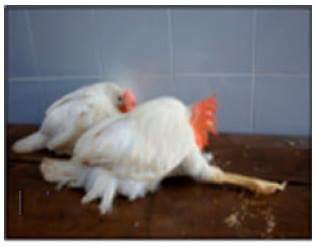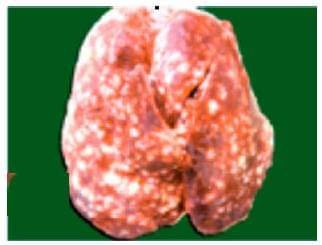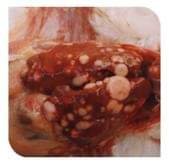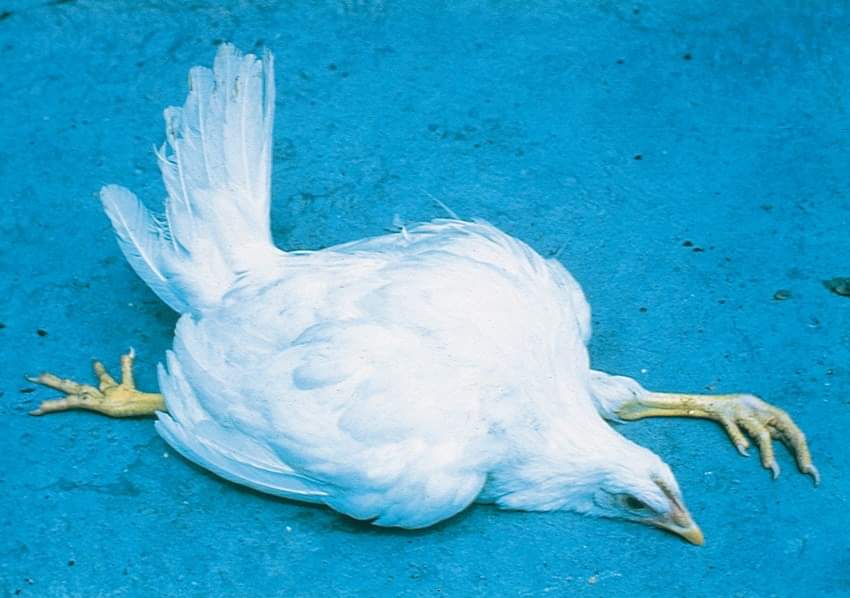MAREK’S DISEASE (MD) IN COMMERCIAL LAYERS & BROILERS
By Dr Vinay Prasad,
Senior Manager, Technical &Sales, Srinivasa Farms
Marek’s Disease (MD) is caused by Marek’s Disease Virus (MDV) and it is a highly contagious oncogenic and neuropathic disease of chickens responsible for great economic losses to the poultry industry worldwide. Sporadic outbreaks of MD have been reported recently throughout the world even in vaccinated flocks
Nature of disease
12-24 weeks of age chicken susceptible to Marek’s disease Contagious viral disease of poultry Gallid herpes virus
• It is highly contagious viral disease of poultry characterized by enlargement of nerves and internal organs.
• It has great economic significance.
Causes
It was named after a Hungarian pathologist (Josef Marek) and also range paralysis because it caused paralysis in chickens, which use to be reared on the range. It affects chickens (all breeds), occasionally pheasants and quail. It occurs worldwide in commercial flocks. Disease is chronic. It takes 4-6 weeks for tumours to form.
Classical type (nervous form) is common in white layers between 6-16 weeks. Visceral type with tumours in various internal organs usually occurs between 16-35 weeks. Infection takes place at very young age, but birds can die of Marek’s disease (MD) near the onset of egg production.
It is caused by a cell-associated Herpes virus containing double-stranded DNA. It has hexagonal naked particles or nucleocapsids of 85 or 100 nM. Enveloped particles of 150-400 nM are occasionally seen in the feather follicle epithelium. There are 3 serotypes. Serotype 1 viruses can be oncogenic (causes tumors). Serotype 2 virus (SB1) and serotype 3 (herpes virus of turkeys -HVT), do not cause tumors and are used as vaccines. One attenuated serotype 1 virus (Rispen’s strain) is used as a vaccine.
• Herpes virus causes this disease.
• Virus can survive at 370C for 24 hrs and in poultry house, droppings, litter, dust, feather follicles and dander for several weeks or months.
• Virus can be inactivated by common chemical disinfectants within 10 minutes of treatment as well as with high humidity.
• The virus matures into a fully infective, envelope form in the epithelium of the feather follicle, from which it is released into the environment.
• It may survive for months in poultry house litter or dust. Dust or dander from infected chickens is particularly effective in transmission.
• Transmission occurs by direct and indirect contacts by air- borne route (aerosols) and inhalation of infective materials mainly dust containing epithelial cells of feather follicles and dander.
• Once the virus is introduced into a chicken flock, regardless of vaccination status, infection spreads quickly from bird to bird.
• Infected chickens continue to be carriers for long periods and act as sources of infectious virus. Shedding of infectious virus can be reduced, but not prevented, by prior vaccination.
• Infective materials can also be transmitted through fomites, personnel and beetles.
• Virus is not transmitted through eggs.
• The incidence of Marek’s disease is quite variable in commercial flocks and depends on strain and dose of virus, age at exposure, maternal antibody, host gender and genetics, other concurrent diseases, and several environmental factors including stress.
Clinical symptoms
It causes increased susceptibility (immunosuppression) to other diseases. Signs include weak, pale, off feed, diarrhoea, poor performance, culls and blindness. In white leghorn type birds, Classical Marek’s is most common: There is paralysis or perisis (partial paralysis). There can be unilateral or bilateral paralysis of wings and legs, mortality, tumours and central nervous system signs (tremors). One leg stretches forward and the other backwards due to leg paralysis.
• Disease appears in two distinct forms, viz. acute and classical form.
• Lameness or paralysis around 12 weeks of age may be indicative of this disease.
• Acute form is manifested with sudden deaths due to formation of lymphomas in the visceral organs.
• Birds may show depression, anaemia, anorexia, emaciation and weight loss, diarrhoea, etc.
• Younger birds from 4 weeks onwards (mostly 6 to 10 weeks) generally suffer from this form and mortality may go as high as 60%.
• Classical form involves lesions in the nerves of birds above 12 weeks with 10-30% mortality occurring over a long period.
• Commonly, there is in coordination, lameness, partial or complete paralysis of wings and legs with birds unable to stand.
• A transient paralysis syndrome (unilateral leg paresis) has been associated with Marek’s disease, causing a characteristic posture of one leg held forward and the other held backward as lesions progress.
• Stretching of legs and wings due to paralysis in either direction will give common appearance of split leg in the disease.
• Twisting of neck (torticollis) results from involvement of cervical nerves and paralysis and dilatation of crop results from involvement of vagus nerves.
• Blindness may also occur due to unilateral or bilateral ocular involvement.
Gross lesions
• Diffuse or nodular lymphoid tumors may be seen in various organs, particularly the liver, spleen, gonads, heart, lung, kidney, muscle, and proventriculus.
• Enlarged nerves are one of the most consistent gross lesions in affected birds.
• Enlarged feather follicles commonly termed skin leukosis may be noted.



CONVENTIONAL MD DIAGNOSIS————-
Primary diagnosis is based on age, clinical signs, history and gross and microscopic lesions. Diagnosis of MD is easier in general in chickens younger than 14 weeks of age, although non-bursal tumors could be caused by REV which must be excluded. However, REV non-bursal tumors are generally not recorded in commercial flocks below 14 weeks of age. Lymphoid leukosis is the most likely to be diagnosed in older birds with bursal tumors, but MD virus and REV both can cause bursal tumors. Occurrence of tumours in older birds in the absence of bursal tumors, MD is the most probable diagnosis. Grossly, the disease is characterized by paralysis of legs (Fig. 1), wings and neck, and tumour nodules in visceral organs (Fig. 2) depending upon the tissue or organ involved. Other observations include grey eye (iris) or irregular pupil, vision impairment, blindness, skin lesions and immunosuppression.
DIFFERENTIAL DIAGNOSIS
The three grossly similar-looking diseases MD, Lymphoid Leukosis (LL) and reticuloendotheliosis (RE) should be differentially diagnosed.
PREVENTION AND CONTROL———
Control of the disease can be achieved by adapting good management practices and vaccination. Chicks should be reared in isolation for 2-3 months from older stocks. Removal of used litter and disinfection of buildings are important to control the disease. Strict bio-security is to be followed to avoid introduction of MDV in the flock. There is no treatment exists for Marek’s disease. Vaccination has been the main approach for its prevention and control throughout the world. Vaccinal immunity, once acquired, is apparently lifelong. However, while vaccination will prevent clinical disease and reduces amount of infective virus shedding thus reducing horizontal disease spread, it will not prevent infection/transmission of the virus. Good management practices along with emphasis on all-in/all-out production, improved sanitation and hygiene, strict biosecurity measures and exploring genetic approaches for increasing the genetic resistance of birds are valuable measures for controlling MD.
MDV vaccination: past, present and future:——————
MD vaccines are highly effective, often achieving more than 90% protection under commercial conditions. Herpes virus of turkey strain FC-126 is widely used and is highly effective against virulent MD virus. A bivalent vaccine consisting of HVT and a serotype-2 strain SB-1 have been found to have synergistic effect and provide better protection against virulent MDV. In-ovo vaccination is the method of choice due to no requirement of chick handling. Immunity develops within two weeks. Because vaccination does not prevent infection with the virus, the MDV has evolved with increased virulence and resistance to this vaccine. As a result, current vaccines used are a combination of vaccines using HVT and gallid herpesvirus type 3 or attenuated MDV strain, CVI988/Rispens
• Vaccination is the one of the most exploited and economical ways of Marek’s Disease control and solid immunity develops after 7 days of vaccination.
• Recommended vaccination schedule for layers:
Age in days Name of vaccine Route
0 MD (Bivalent) S/C
7-10 MD (Bivalent) S/C
• Now days, in ovo vaccination (in 18 days old embryo) are done with automated technology in many developed countries.
• Procurement of stocks from Marek’s Disease resistant sources followed by regular testing for Marek’s Disease.
• All-in-and-all-out policy of rearing the stocks minimizes the chances of disease in vaccinated flocks by breaking the infection cycle with disinfection.
• Strict biosecurity along with adequate hygiene and sanitation in addition to vaccination are essential for prevention of the disease.
• After outbreaks, premises should be disinfected with 5% formalin and kept without stocks for at least one month.
Reference:On request.


